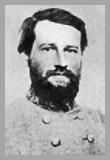
Organization

Gen. John C. Pemberton
Commander, Vicksburg Garrison
This heavy artillery regiment was originally organized as a part of the Louisiana state forces.
Although the regimental headquarters remained at New Orleans, the various companies
comprising the regiment served in various locations. Companies B, C, D, E, F, H, and K
served at Forts Jackson and St. Philip below New Orleans and were surrendered when that
city was captured by Union forces on April 26, 1862. The three remaining companies went
to Vicksburg, Mississippi, about May 20, 1862 to help man the river batteries. During the
fall of 1862, the men captured at New Orleans were exchanged and most of them returned
to their commands. The regiment was surrendered at Vicksburg on July the 4th, 1863 and
was paroled several months later at Enterprise, Mississippi. It then aided in the defense of
Mobile and at the battle of Tupelo on July 14, 1864, acting as an infantry reserve under
Gen. Stephen D. Lee for Nathan Bedford Forrest's Cavalry forces. The men of the
regiment evacuated Mobile when that city fell and were included in the surrender on May 8,
1865.
Date Organized: February 5, 1861 Organized at: New Orleans, La. Mustered into Confederate service: March 13, 1861 Mustered in at: New Orleans, La. Civil War Regimental Information System

Gen. John S. Bowen
/Artillery

Gen. Nathan Bedford Forrest
Organized February 5, 1861, as part of the Louisiana State Army, the 1st Heavy Artillery transferred to Confederate service March 13, 1861, with 744 men. Regimental headquarters remained at the New Orleans Barracks while the various companies occupied the forts of the New Orleans defenses. Throughout the fall and winter of 1861, Companies B, C, D, E, F, H, and K served in Fort Jackson and Fort St. Philip below New Orleans. Companies A and I helped defend Fort Pike, and Company G composed part of the Fort Macomb garrison. The companies at Jackson and St. Philip fought well against Union admiral David G. Farragut's fleet during the bombardment and passage of the forts and were included in the surrender and parole of the garrisons on April 26, 1862. Company I participated in the brief skirmish with the Union fleet at the McGehee Lines on April 25. Company A and G evacuated their posts on April 26 and joined Company I at Camp Moore on May 3, 1862. About May 20, 1862 these three companies left for Vicksburg, Mississippi, to help man the river batteries defending that city. They served in a temporary battalion commanded by Major Henry A. Clinch during the first attack on Vicksburg, May 18 - July 27, 1862. The officers and men captured at Jackson and St. Philip received their exchanges in the fall, and most of them returned to their command. During the fall and winter of 1862 - 63, the regiment suffered heavily from sickness; and at one point nearly 500 conscripts augmented its depleted ranks. The men manned the cannons in the lower (southern) river batteries at Vicksburg. On March 11, 1863, Company A moved to Grand Gulf to occupy the upper (northern) battery there. In an engagement with Federal gunboats on March 31, the company distinguished itself by its excellent firing. This company again engaged the enemy on April 29 and participated in the evacuation of the post on May 3. During the siege of Vicksburg, May 19 - July 4, 1863, the regiment fired its cannons at enemy gunboats on the river and enemy batteries on the Louisiana shore. The 1st Heavy Artillery marched out of Vicksburg after the surrender there and went into a camp for paroled prisoners at Enterprise, Mississippi. Major General Dabney H. Maury requested the regiment's services at Mobile, Alabama, after it was exchanged; and the regiment arrived there on January 16, 1864. From that time until summer, the companies manned various redoubts along the Mobile land defenses. Twice during July, 1864, the regiment moved to Meridian, Mississippi, to support Major General Stephen D. Lee's cavalry force. At the Battle of Tupelo, July 14, 1864, the men acted as an infantry reserve. The regiment reoccupied redoubts at Mobile in early August, 1864, and late that month the companies moved to two water batteries on islands in upper Mobile Bay. The regiment continued to garrison these batteries until April 11, 1865, when they were dismantled and their men evacuated as part of the evacuation of Mobile. When Lieutenant General Richard Taylor's army surrendered, on May 8, 1865, the 1st Heavy Artillery was camped at Cuba Station, Alabama; and the men received their paroles at Meridian as part of Taylor's army.
(Guide to Louisiana Confederate Military Units, pp 7-9)
